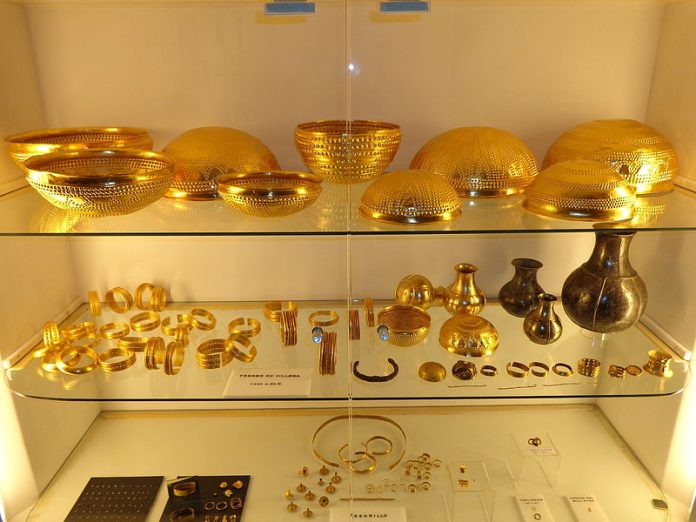A new study indicates that the two iron artefacts (a hollow hemisphere and a bracelet) in the Treasure of Villena were made using extra-terrestrial meteoritic iron. This suggests that the Treasure was produced in the Late Bronze Age before the production of terrestrial iron started later in the Iron Age.
Treasure of Villena, a unique set of 66 pieces of various metals, is considered the most important prehistoric treasure in Europe. The Treasure was discovered in 1963 near Villena city in Alicante province of Spain and is exhibited in the local José María Soler Archaeological Museum. The remains were hidden 3,000 years ago and belong to the Bronze Age. However, presence of two metallic pieces of iron (a hollow hemisphere cap and a bracelet) in the Treasure had led many to lower the chronology to to the Late Bronze Age or the Early Iron age. The original discoverer also had noted the ‘iron appearance” of the two pieces. Hence, the need to confirm the identification of iron.
It was proposed to analyse the two objects with the “iron appearance” to determine whether they are made of terrestrial iron. If found to be made of terrestrial iron, then the Treasure should belong to the Late Bronze or early Iron Age. Meteoritic origin, on the other hand would mean an earlier date within the Late Bronze.
Meteoritic iron is of extra-terrestrial origin and is found in certain types of meteorites that fall to Earth from outer space. They are composed of an iron-nickel alloy (Fe-Ni) with a variable nickel composition that is often greater than 5% and other minor trace elements such as cobalt (Co). Most of the Fe-Ni meteorites have Widsmanstätten microstructure which can be recognised through the metallography of a fresh metal specimen. The composition of terrestrial iron obtained from reduction of minerals found on Earth, on the other hand, is different. It has little or no nickel that can be detected analytically. The differences in composition and microstructure can be studied in the laboratory to determine whether any iron piece is made of extraterrestrial meteoritic iron or terrestrial iron.
The researchers analysed the extracted samples. The findings support the view that the two iron pieces (viz. the cap and bracelet) in the Treasure of Villena are made of meteoritic iron hence the chronology of Late Bronze Age prior to the beginning of the production of terrestrial iron. However, further tests are needed to improve the degree of certainty.
The use of meteoritic iron in the Treasure of Villena is not unique. Meteoritic iron has been detected in the artefacts from other archaeological sites in Europe such as in an arrowhead in Mörigen (Switzerland).
***
References:
- Council of Tourism. Treasure of Villena and José María Soler Archaeological Museum. Available at https://turismovillena.com/portfolio/treasure-of-villena-and-archaeological-museum-jose-maria-soler/?lang=en
- Rovira-Llorens, S. ., Renzi, M., & Montero Ruiz, I. (2023). Meteoritic iron in the Villena Treasure?. Trabajos De Prehistoria, 80(2), e19. DOI: https://doi.org/10.3989/tp.2023.12333
***






































